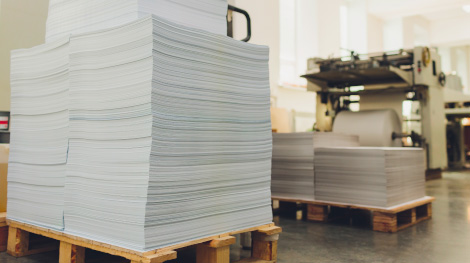Logistical supply chain management in the publishing industry has never been more challenging. Rising costs, paper shortages and uncertainties such as COVID-19 and the Red Sea diversion of 2024 hit the sector hard.
According to the industry monitor EUWID Pulp and Paper this month Italian producer Burgo has implemented significant increases in paper pricing. They are just one of many suppliers who have hiked their prices recently. Furthermore, two of the most common types of paper used in book production have seen their price per tonne increase by nearly 50%. That is an eye-watering cost increase. One that is putting unprecedented pressure on publishers.
But the industry itself is in exciting shape. 212 million books left the shelves in 2021, the highest figure for a decade. It can confidently be said that eBooks have not killed printed books. Both have their place in the modern world.
So, how can you overcome these obstacles, to take advantage of this buoyant market? Well, one answer lies in building a proactive supply chain, instead of a reactive one. Let’s explore how.

Choosing where to print research paper.
The guide covers the strengths and weaknesses of the Chinese printing market, and other specialist print locations. Vital for any publishing company wanting to add resilience to its supply chain.
It might be time to reconsider your printing locations
With freight rates showing volatility, questions are being asked whether we will ever get to a period of stability. But with growing geopolitical tensions, it's hard to see.
So, the question becomes whether moving your printing locations closer to their market would cut costs for the business, or at least bring stability. After all, reduced book miles mean lower costs therefore it’s certainly an avenue worth exploring. Lower costs in transportation could more than offset a potential rise in production costs from moving closer to home.
But extortionate freight rates are not the only driving factor for moving production to central or eastern Europe. Long transit times, port congestion and difficult scheduling are all challenges that are solved by moving production.
You’d also knock roughly 90% off your transit distance and with it a considerable portion of transit time too. All of which builds a more streamlined and efficient logistical supply chain.

We also cannot forget the environmental advantages of relocation. Transportation is a highly polluting part of a business's operations. In fact, transport alone was responsible for 27% of the UK’s total emissions in 2019. The highest contributing sector. So, reducing those product miles is a large step in the direction of sustainability.
There is also an inventory saving. Your need for stockpiling raw materials to keep supply flowing is reduced. That means money is saved on warehousing as you print in smaller quantities, but more often.
With many printers to choose from in the European market who want your business, there is downward pressure on pricing. A cost-effective solution could be out there for you.
However, a more eastern European based supply line wouldn't come without challenges. Printing in China still leads European nations when it comes to quality. China have better infrastructure for this kind of service currently. Although European nations are attempting to catch up, currently they are behind when it comes to providing the finest finished product on a mass scale.
Utilise data and end-to-end visibility
No question the easiest logistical supply chain enhancement you can make to overcome disruption lies in data and visibility.
There are so many tools out there offering easy access to extremely helpful information related to your supply chain. Once set up, they will automatically feed vital information/data straight to you, so you can see where problems lie and make improvements.
The range of data available really is endless. Here are just some of the examples:
- Current location of shipments.
- Cost breakdowns.
- Timing for specific containers, routes or transit types.
- CO2 footprint monitoring.
- Total trade volumes and costs, broken down by port, country, region, container or transport type.
Over time these insights offer real competitive advantage. It becomes staggeringly easy to spot weaknesses. Like certain routes costing too much or taking too long. Or whether there is a port or product type consistently causing disruption. It all feeds straight to your computer or mobile app on an easily digestible platform.
The opportunities presented by quality supply chain data really cannot be overstated. It really is the only way to future-proof your logistics.
At WTA we have our own data and end-to-end visibility platform. To learn more about WTA's visibility platform, follow the link below.
Or, explore the difference between logistics and supply chain management and how both are crucial to business success.






